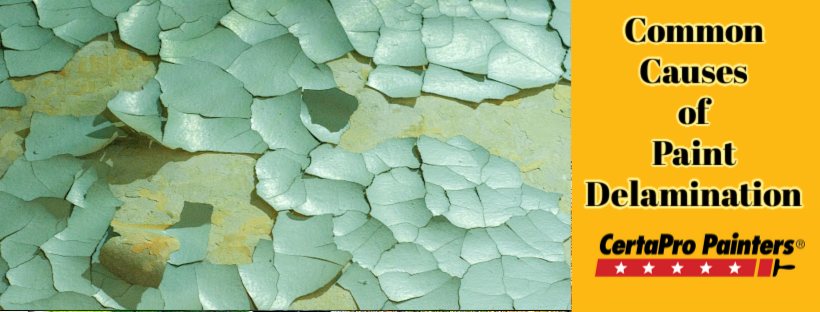
Common Causes of Paint Delamination
Posted on May 2, 2022
When it comes to determining specifically why there is paint delamination, there are generally four potential causes for why the paint is failing. The following is a summary of each of the failure types. Any one of these, or a combination of them can be the likely cause of a failure.
The Causes of Paint Delamination
Saponification of Paint
Saponification of paint is a chemical reaction that occurs when newly plastered substrates are painted with oil paint.
Newly plastered substrates have high alkalinity, until they have cured to a neutral ph. If new oil paint is applied to a surface with high alkalinity, there will be a hydrolytic breakdown of ester bonds. Ultimately, this chemical reaction creates a thin powdery film (soap) between the plaster and paint, thus affecting long-term durability and adhesion.
Overtime and sporadically, paint will often delaminate in isolated locations. This type of saponification will take place as a larger event rather than bits & pieces here and there.
Thermal Shock
Modern buildings have reasonable and generally consistent environmental controls (i.e., heating and cooling systems). These systems typically regulate humidity and offer steady climate control.
When a building is without climate control for a long period of time, this causes the building’s temperature and humidity to be not regulated.
This will cause damage when the building returns to a climate controlled state, many of the substrates experience thermal shock. This will be especially evident if materials expand and contract at a rapid rate during the large degrees of temperature change over a short period of time.
In the case of thermal shock, paint film could be expanding and contracting at a different rate than the plaster and framing behind it, which can lead to a separation or weakening of the paint bond to the plaster substrate.
New Paint Coatings on Top of too Many Multiple Existing Paint Layers
Modern paints, especially acrylics are meant to adhere to the layer the paint is applied to, much like a glue. However, traditional oil paints were applied in a thinned-down fashion. This was to penetrate the substrate with coating as much as possible.
Multiple thin coats of oil paint were needed to create a solid and opaque paint film on the surface. This process was time consuming and very labor intensive. Today, acrylic paint is more popular than oil paints because it requires less application time and attention.
Generally, acrylic paints have high adhesion and bond very well to paint layers below it.
If acrylic paint is applied to old layers of oil paint, it will penetrate the surface and soften the previous layers of paint on the substrate until all the paint dries and evaporates. As this acrylic paint dries, it will shrink. As it shrinks, its bond to the paint layers beneath it becomes stronger and that paint will come off with the acrylic all together.
In other words, the new paint being applied is literally pulling the old paint off the wall.
Age of Original Paint
If the original paint coatings are old (i.e., approx. 100 years old), they could quite possibly surpass its serviceability. No matter what kind of paint you try to apply over this will cause cracking, peeling and impurities will always show. You must remove this old paint and start over to be successful.
Saponification, thermal shock, lots of old paint layers, and ancient paint are the enemies of beautiful, flassless, painted surfaces. CertaPro can help you decide what to do about all your interior and exterior paint issues. Call us and you will never have to worry about paint delamination again.
Do you have peeling, cracking & bubbling paint on your walls? Call CertaPro Painters of Twin Cities East today at 612-803-2248 or go online to schedule an estimate today.





